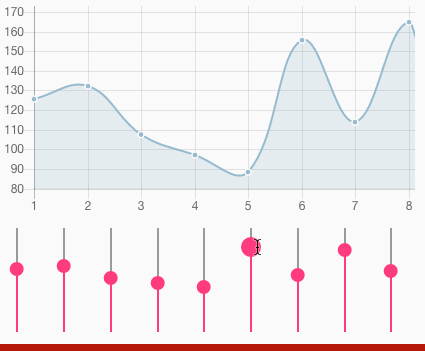I have a simple linear chart built with Chart.js library.
And i want to allow user to drag points on chart for dynamically change data of it. I tied chartjs-plugin-draggable but it works for me only with annotations. I need graph exactly like this:
https://www.rgraph.net/canvas/docs/adjusting-line.html
But use new graph library in project is not good solution :(
Also i tried to play with dot event's.
UPDATE:
With angular i created something like this.

Maybe if there is no way to add drag&drop to points, there will be a hack to put "sliders" with absolute position on graph on points positions. I didn't find any info too :(
In case anyone is looking for a solution that doesn't require the use of plugins, it's pretty straightforward to do it in vanilla
chart.js.Here's a simple working example - just click and drag a data point
Update: My previous answer got deleted because it only featured a link to a plugin solving the issue, however here comes the explanation to what it does:
The general procedure on how to achieve the desired behaviour is to
getElementAtEventfunctionaxis.getValueForPixelfunctionchart.update(0)as pointed out in this Chart.js issue.
In order to intercept the mousedown, mousemove and mouseup events (the dragging gesture), event listeners for said events need to be created. In order to simplify the creation of the listeners one may use the d3 library in this case as follows:
On mousedown (the
'start'event here), a function (getElement) may be called thatfetches the closest chart element to the pointers location and gets the ID of the Y-ScaleOn mousemove (
'drag'), the chart data is supposed to be updated according to the current Y-Pixel value of the pointer. We can therefore create anupdateDatafunction that gets the position of the clicked data point in the charts data array and the according dataset like thisAnd that's it! If you need to store the resulting value after dragging, you may also specify a
callbackfunction like thisHere is a working fiddle of the above code. The functionality is also the core of the Chart.js Plugin dragData, which may be easier to implement in many cases.
Here is how I fixed using both touchscreen or mouse event x,y coordinates for the excellent d3 example above by wrapping event screen coordinates in a more "generic" x,y object.
(Probably d3 has something similar to handle both types of events but lot of reading to find out..)
.. and here is how I would use it in the above d3 example to store the initial grab point Y. And works for both mouse and touch.
Check the Fiddle
Here how I solved the problem with using d3 and wanting to drag the document on mobile or touch screens. Somehow with the d3 event subscription all Chart area events where already blocked from bubbling up the DOM.
Was not able to figure out if d3 could be configured to pass canvas events on without touching them. So in a protest I just eliminated d3 as it was not much involved other than subscribing events.
Not being a Javascript master this is some fun code that subscribes the events the old way. To prevent chart touches from dragging the screen only when a chart point is grabed each of the handlers just have to return true and the event.preventDefault() is called to keep the event to your self.
The handler above is initiated like this with an existing Chart.js object:
The beginDrag(evt), duringDrag(evt) and endDrag(evt) have the same basic function as in the d3 example above. Just returns true when wanting to consume the event and not pasing it on for document panning and similar.
Try it in this Fiddle using a touch screen. Unless you touch close to select a chart point the rest of the chart will be transparent to touch/mouse events and allow panning the page.